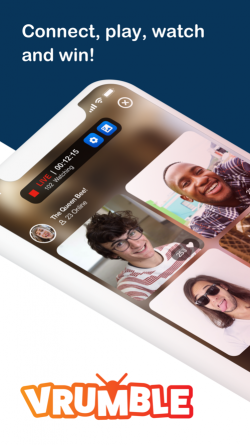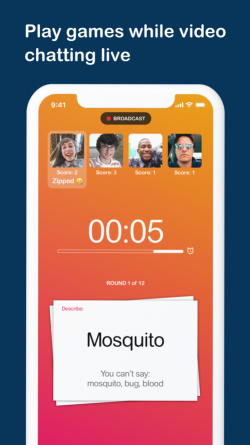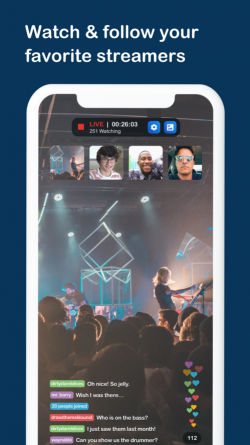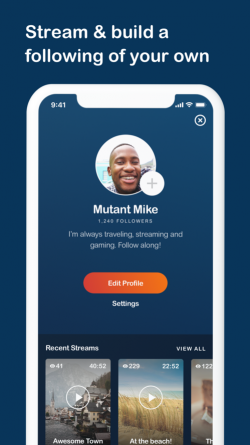Twitch for Mobile Gaming: Vrumble Goes Live With Wowza

Case Study Snapshot
| Industries | ||
 Streaming service provider Streaming service provider |
||
| Products/Services | ||
| Wowza GoCoder SDK | Wowza Video with Ultra Low Latency | |
| Use Case | ||
| Mobile app for broadcasting video game streaming, premium live video content and user-generated video streaming | ||
Mobile apps that allow users to create and share their own live videos are becoming more and more popular, with the rise of platforms such as Twitch and Facebook Live. And now there’s a new app in town: Vrumble, made by Tesuji Games Inc. It’s a live-streaming mobile app that incorporates augmented reality (AR), geo-aware capabilities and group video chat to allow multiple users to broadcast themselves playing a game, hosting a show, participating in a class and more.![]()
But these kinds of interactive experiences rely on real-time streaming in order for authentic exchanges to take place. When developing Vrumble, the solutions the team at Tesuji tried all offered latency that was too high.
That is, until they found the Wowza Video service with Ultra Low Latency. Together, Vrumble and Wowza are leading the way in interactive, user-generated streaming innovation.
Tesuji Games Seeks Low-Latency Streaming for Interactive Video App
The goal of Vrumble, says Benji Brown, CEO of Tesuji Games, is to “create a mixed-reality social-experience community” and to “connect people through play.” Now available for iOS in the Apple app store (with an Android version in development), Vrumble allows multiple users to have a group video chat while sharing the same live-streamed experience, and to broadcast all the action to current followers and new audiences.
 In addition to video game streaming, the app is also home to original live programming such as cooking, fitness, makeup and talk shows. Viewers can interact with the broadcaster and with each other via text or video chat, or by sending “emoji bursts” to show love to the streamer.
In addition to video game streaming, the app is also home to original live programming such as cooking, fitness, makeup and talk shows. Viewers can interact with the broadcaster and with each other via text or video chat, or by sending “emoji bursts” to show love to the streamer.
When they began building the Vrumble app, Brown says, his team kept running into the same problem with the streaming services they used: latency was too high. Anything that used Apple’s HTTP Live Streaming (HLS; the current industry standard protocol for iOS), even when tuned for lower-latency streaming, still introduced anywhere from 15 to 30 seconds of lag from end to end.
This kind of latency is far too high for interactive streaming. Imagine a conversation where you asked someone a question, and it took them 30 seconds to answer you; in this case, authentic communication would be impossible. In the case of live video, viewers and streamers alike will quickly lose interest.
“So, then we had the idea of maybe using some meshed WebRTC solutions, but those actually didn’t perform correctly because of some conflicts at the engineering level with some of our other architecture,” Brown says. “Because of how we have all these games injected and other capabilities within the app, … it didn’t provide a solution.”
But then the team at Tesuji discovered Wowza Video with Ultra Low Latency, and everything changed.
Wowza Tech Powers Truly Interactive Content
Brown had used Wowza streaming products in the past to build a custom streaming solution for a film festival. Remembering the high quality of the technology, he sought the company out again. When the Tesuji team discovered the Ultra Low Latency service was available, he was eager to try it out (at the time, it was in preview). The team discovered that the service provided the real-time, sub-three-second end-to-end streaming delivery their app demanded, and they’ve used it ever since.
After choosing to work with Wowza, Tesuji Games used the Wowza GoCoder™ SDK to build their own custom app infrastructure utilizing the Ultra Low Latency API. Today, their platform not only supports broadcasts with super-fast streaming, it also allows users to overlay custom video and audio frames on top of the main live stream for an engaging AR experience. Content creators can add titling and graphics, and Vrumble can include IFrame ads on the viewer’s side for revenue purposes.
“The Ultra Low Latency service … allowed us to inject our own custom frames and audio frames so [we could] broadcast quickly,” says Brown. “Plus, the playback through GoCoder allowed us that interactivity and low latency that we needed. So, when I do something funny on my show and then someone comments on it, that constant communication is really snappy, and allows people to have the [necessary] conversation for this real-time interactivity use case that we have.”
In addition to support for these kinds of real-time interactions, Brown also likes that the Ultra Low Latency service allows his team to integrate third-party platforms such as Wirecast and Open Broadcaster Software (OBS). They use these tools to stream in the original talk and special-interest shows produced outside the Vrumble app, he says, and plan to produce more of this type of daily and weekly content.
Ultimately, Brown adds, the main goal is for all content creators to go through the Vrumble platform. Tesuji plans to eventually release a creative studio platform to eliminate the need for third-party integrations for produced shows. Indeed, live user-generated content is more popular than ever, and since just about every consumer has a camera in their pocket at all times, mobile devices are the most common vehicle for any user who wants to create, share and interact with live content.
“The main goal is [for] people to go mobile-to-mobile, and really use this multi-party video-chat capability that is in Vrumble, and share it with thousands of people through the live-streaming capabilities that the Ultra Low Latency service has provided,” says Brown.
 According to Brown, the game-streaming capabilities of Vrumble can be thought of like “Twitch for mobile gaming.” Users can broadcast their mobile gameplay, see the screens of other users who are playing, interact with other users through chat and send emojis. But, unlike Twitch, Vrumble doesn’t require extra equipment or third-party add-ons, such as Skype integration, to facilitate multi-party viewing and interaction.
According to Brown, the game-streaming capabilities of Vrumble can be thought of like “Twitch for mobile gaming.” Users can broadcast their mobile gameplay, see the screens of other users who are playing, interact with other users through chat and send emojis. But, unlike Twitch, Vrumble doesn’t require extra equipment or third-party add-ons, such as Skype integration, to facilitate multi-party viewing and interaction.
“It’s like we’re in the same room having a game night. You can have four people video chatting, all playing a trivia game together,” Brown describes. “And we have an SDK, so we can take the Vrumble live-streaming experience and video-chat experience and let other game developers integrate our Vrumble ecosystem into their app. We’re going to see the breadth of the number of games that have the Vrumble aesthetic in them expand a ton.”
At the time of this writing, live streaming through the app was only available to approved broadcasters, in an effort to ensure that the subject matter of content remains appropriate as the app expands its user base. Eventually, the live video feature will be available to all users, and Wowza Streaming Engine™ software will be leveraged along with the Ultra Low Latency service to support video on demand (VOD) streaming, which will help promote original programming.
The API Built for Streaming Powers Live User-Generated Video Experiences
As mentioned, the Wowza Video platform with Ultra Low Latency is fully accessible via API. This enabled a world of possibilities for Tesuji Games in creating an interactive content experience.
“The API was really helpful and usable as we built up our own infrastructure. … The Ultra Low Latency service provides this ability to spin up streams, delete streams and provide endpoints for various coders to push video frames to. But, to build a full-fledged application or ecosystem, you have to build a lot of stuff on top of that. Leveraging the Ultra Low Latency API allowed us to easily build our more complicated application-specific infrastructure. And it also allowed us to manage through the API how we distribute those streams to our various broadcasters.” —Benji Brown, CEO at Tesuji Games Inc.
The benefits Tesuji Games realizes as a result of building on Wowza Video with Ultra Low Latency and the Wowza GoCoder SDK include:
- Sub-three-second end-to-end streaming delivery, enabling interactive experiences and authentic conversations between viewers and broadcasters.
- An SDK that facilitates the creation of multi-party gaming, AR and interactive programming experiences.
- An API that’s built to build on, allowing the Vrumble ecosystem for interactive streaming to be easily developed and deployed.
Live user-generated video experiences incorporating multi-party streaming, AR elements and interactive programming are only going to become more popular. Working with Wowza, Tesuji and Vrumble will continue to be on the forefront of this exciting new territory. We can’t wait to see what else they create.




